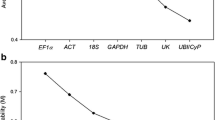Abstract
Black root rot, caused by Thielaviopsis basicola, is a serious disease of cotton in Australia, causing necrosis of the root cortex, delayed seedling development and fruit set, and yield loss when severe. We investigated the potential for acibenzolar-S-methyl to induce resistance in cotton against T. basicola in naturally infested soil. In pot experiments, soaking seeds in solutions of acibenzolar-S-methyl (25 or 50 μg/mL for 3 to 5 h before planting) consistently reduced disease severity on tap roots by 20–30%. In field experiments, acibenzolar-S-methyl was applied either as a spray over the seed during sowing (in-furrow spray), as a seed dressing, by the soaking method, or as foliar sprays over seedlings. In the field, seed-soaking reduced the severity of black root rot on tap roots by 33%. The in-furrow spray (25 μg acibenzolar-S-methyl/mL at 550L/ha) reduced the severity of symptoms on tap roots by 24%, increased the number of relatively healthy lateral roots by 350% and increased fruit number by 29%. Seed dressing with 3.3 mg acibenzolar-S-methyl/kg seed did not affect disease severity, whereas 6mg/kg reduced the severity on tap roots by 20%. The foliar sprays were ineffective. To our knowledge, this is the first report of the induction of systemic acquired resistance against a soilborne plant pathogen in the field using a chemical seed treatment. With appropriate rates and application methods, acibenzolar-S-methyl has potential as a component in an integrated disease management strategy for black root rot of cotton.
Similar content being viewed by others
References
Allen SJ (2001) Black Root Rot. In ‘Compendium of Cotton Diseases, second edition’ (Eds TL Kirkpatrick, CS Rothrock). (The American Phytopathological Society. St Paul. MN)
Ali Z, Smith I, Guest D (2000) Combinations of potassium phosphonate and Bion (acibenzolar-S-methyl) reduce root infection and dieback of Pinus radiata, Banksia integrifolia and Isopogon cuneatus caused by Phytophthora cinnamomi. Australasian Plant Pathology 29, 59–63. doi: 10.1071/AP00009
Benhamou N, Belanger RR (1998a) Induction of systemic resistance to Pythium damping-off in cucumber plants by benzothiadiazole-ultrastructure and cytochemistry of the host response. The Plant Journal 14, 13–21. doi: 10.1046/J.1365-313X.1998.00088.X
Benhamou N, Belanger RR (1998b) Benzothiadiazole-mediated induced resistance to Fusarium oxysporum f. sp. radicis-lycopersici in tomato. Plant Physiology 118, 1203–1212. doi: 10.1104/pp. 118.4.1203
Colson ES (1997) Systemic induced resistance in cotton. PhD Thesis, The University of Sydney, 199 pp.
Colson-Hanks ES, Allen SJ, Deverall BJ (2000) Effect of 2,6-dichloroisonicotinic acid or benzothiadiazole on alternaria leaf spot, bacterial blight and Verticillium wilt in cotton under field conditions. Australasian Plant Pathology 29, 170–177.
Colson-Hanks ES, Deverall BJ (2000) Effect of 2,6-dichloroisonicotinic acid, its formulation materials and benzothiadiazole on systemic resistance to alternaria leaf spot in cotton. Plant Pathology 49, 171–178. doi: 10.1046/j.l365-3059.2000.00439.x
Dann EK, Diers B, Byrum J, Hammerschmidt R (1998) Effect of treating soybean with 2,6-dichloroisonecotonic acid (INA) and benzothiadiazole (BTH) on seed yields and the level of disease caused by Sclerotinia sclerotiorum in field and greenhouse studies. European Journal of Plant Pathology 104, 271–278. doi: 10.1023/A: 1008683316629
Hawes MC, Brigham LA (1992) Impact of root border cells on microbial populations in the rhizosphere. Advances in Plant Pathology 8, 119–148.
Hillocks RJ (1992) ‘Cotton diseases’. (CAB. International, Wallingford, United Kingdom)
Holtz BA, Weinhold AR (1994) Thielaviopsis basicola in San Joaquin valley soils and the relationship between inoculum density and disease severity of cotton seedlings. Plant Disease 78, 986–990.
Jensen BD, Latundedada AO, Hudson D, Lucas JA (1998) Protection of Brassica seedlings against downy mildew and damping-off by seed treatment with CGA 245704, an activator of systemic acquired resistance. Pesticide Science 52, 63–69. doi: 10.1002/(SICI)1096-9063(199801)52:1<63::AID-PS660> 3.0.CO;2–2
Kessmann H, Staub T, Hofmann C, Maetzke T, Herzog J, Ward E, Uknes S, Ryals J (1994a) Induction of systemic acquired resistance in plants by chemicals. Annual Review of Phytopathology 32, 439–459. doi: 10.1146/annurev.py.32.090194.002255
Kessmann H, Staub T, Ligon J, Oostendorp M, Ryals J (1994b) Activation of systemic acquired resistance in plants. European Journal of Plant Pathology 100, 359–459. doi: 10.1007/BFO 1874804
King CJ, Presley JT (1942) A root rot of cotton caused by Thielaviopsis basicola. Phytopathology 32, 752–761.
Kuc J (1982) Induced immunity to plant disease. Bioscience 32, 854–860.
Linderman RG, Toussoun TA (1967) Behavior of chlamydospores and endoconidia of Thielaviopsis basicola in non-sterilised soil. Phytopathology 57, 729–731.
McFadden HG, Chappie R, de Feyer R, Dennis E (2001) Expression of pathogenesis-related genes in cotton stems in response to infection by Verticillium dahliae. Physiological and Molecular Plant Pathology 58, 119–131. doi: 10.1006/pmpp.2001.0320
Mondal AH (2001) Systemic induced resistance in legumes and cotton. PhD Thesis, The University of Sydney, 219 p.
Nehl DB, Allen SJ, Mondal AH, Lonergan PA (2004) Black root rot: a pandemic in Australian cotton. Australasian Plant Pathology 33, 87–92. doi: 10.1071/AP03085
O’Niell G (1997) Thielaviopsis — a grower’s perspective. In Proceedings of the Beltwide Cotton Production Research Conferences p. 75. National Cotton Council of America: New Orleans.
Owen KJ, Green CD, Deverall BJ (2002) A benzothiadiazole applied to foliage reduces development and egg deposition by Meloidogyne spp. in glasshouse-grown grapevine roots. Australasian Plant Pathology 31, 47–53. doi: 10.1071/AP01068
Rothrock CS, Nehl DB (2000) Reproductive potential of Thielaviopsis basicola on plant species and response of chlamydospores to host and nonhost exudates. Phytopathology 90, S67.
Walker NR, Kirkpatrick TL, Rothrock CS (1998) Interaction between Meloidogyne incognita and Thielaviopsis basicola on cotton (Gossypium hirsutum). Journal of Nematology 30, 415–422.
Zeringue HJ, Shih BY (2000) Induced chemical changes and aflatoxin control related to pre-sowed seed treatments in cotton. Phytopathology 90, S88.
Zhao S, Guo J (2003) Systemic acquired resistance and signal transduction. Agricultural Sciences in China 2, 539–548.
Author information
Authors and Affiliations
Corresponding author
Rights and permissions
About this article
Cite this article
Mondal, A.H., Nehl, D.B. & Allen, S.J. Acibenzolar-S-methyl induces systemic resistance in cotton against black root rot caused by Thielaviopsis basicola . Australasian Plant Pathology 34, 499–507 (2005). https://doi.org/10.1071/AP05089
Received:
Accepted:
Issue Date:
DOI: https://doi.org/10.1071/AP05089




